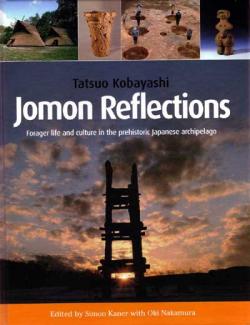Jomon Reflections: Forager life and culture in the prehistoric Japanese archipelago

By Tatsuo Kobayashi
Edited by Simon Kaner and Oki Nakamura
Oxbow Books; (2003)
ISBN-13: 978-1842170885
Review by Sir Hugh Cortazzi
The Jomon (??) period in the prehistory of Japan lasted from the thirteenth century BC to the end of the first millennium BC. Following the Palaeolithic period it preceded the Neolithic, called in Japan the Yayoi period. The Jomon peoples were basically hunter-gatherers but developed village communities and learnt how to make pottery for cooking, food storage and ceremonial purposes. This made them similar to Neolithic and Bronze Age peoples, although they never developed any form of metal working. Jomon culture was very long lasting covering some 12,000 years, but it naturally changed over the millennia.
Archaeologists have found Jomon sites in many parts of Japan and many pots which have helped them to reconstruct a picture, if somewhat hazy, of the culture which the Jomon peoples developed and which was in many ways more advanced than that of other peoples elsewhere in Asia of that time.
This book sets out the results of archaeological research on this lengthy period in Japan. It is copiously illustrated in colour and the text includes explanatory diagrams. The book emphasises that Jomon was "a time of considerable cultural creativity, established on stable ecological and social foundations" (page 2).
The invention of pottery, which began in the earliest stages, was a highly significant development of human technology for the prehistoric inhabitants of the Japanese archipelago and implied a change from a nomadic to a sedentary existence. According to radiocarbon dating pottery fragments found in Japanese sites are the oldest dated pottery in the world. This does not necessarily mean that pottery was invented in Japan although this seems possible.
From the outset pottery in Japan was used for cooking and storage of food and liquids. It "enabled a dramatic increase in the range and quantity of food that could be prepared and consumed" (page 22). One example is shellfish which could be opened after cooking. Meat could also be boiled in pots rather than roasted over heated stones.
A particular characteristic of Jomon pottery is that much of it is decorated with cord markings. These were so prominent that the period was called after them. Archaeologists concluded that the cord-marks were made as a result "of rolling/rotating the cord and pressing it on to the surface of the pot."
In chapter three the various stages in the development of Jomon pottery are outlined although the forms and designs were never static. Some of the early vessels made already showed considerable elegance and artistry as for instance a deep vase with a rim of four pointed and outward-splayed wings (page 38, figure 3.13). The full potential of Jomon pottery was achieved in the middle to final periods.
In the middle period pots began to be used for burial urns and lamps suggesting more ritual and ceremonial uses. Archaeologists have termed this "the application stage." Fine examples of this stage are those illustrated on page 44 (a deep pot with "dagger" motifs) and two on page 46 (one a deep pot with "dancers" and another in "arabesque style").
In the following chapter "The lands of Jomon Japan" a description is given of the different areas in Japan where some seventy major styles developed. One of the most striking was that of the so-called "Flame" pots which were produced in an extensive area along the Japan Sea coast. Fine examples of such pots are illustrated on pages 61 and 67. The period in which this style of pots was created was relatively short. In late Jomon period pots with lids began to be made.
In chapter five the types of foods and drink consumed by the Jomon people are described. It seems clear that while agriculture was not practiced nut bearing trees were cultivated. Acorns, which are not edible unless the tannic acid which they contain is removed, were an important source of nourishment in the winter months. The process to remove tannic acids is a labour intensive one and shows the extent of the development of Jomon society. Nuts were apparently ground with stones and made into dumplings which were boiled or baked.
Dogs were some of the first domesticated animals but it also seems, not least from the pottery figurine illustrated on page 87, that boars may also have been domesticated. Other materials used in the late Jomon period included asphalt and lacquer. Sophisticated examples of the latter are illustrated on page 90.
In chapter six on "settlement and society" the book analyses the types of houses, including pit dwellings, and villages used by Jomon people.
The final two chapters discuss what is known about religious practices and attitudes of the various peoples in the different settlements. Dependence on nature is reflected in the number of phallic shaped stones. The first clay figurines were made without faces (see for instance the standing figurine illustrated on page 147). Some later figurines such as those illustrated on page 152 had goggle eyes and more sophisticated shapes. The exact role of the figurines in Jomon culture is the subject of much speculation among archaeologists.
Three and five seem to have been important numbers for the Jomon peoples; interestingly three, five and seven are still important for Japanese today.
The seasons were naturally very important in early societies and the solstices seem to have had a special place in the calendar. A photograph at the bottom of page 187 shows the bases of six wooden posts for a large Jomon building which were found at a site in Northern Japan. Kobayashi Tatsuo, the Japanese archaeologist and author of this study shows in the upper photograph on this page how the midwinter sun sets between the two lines of posts. This photograph provides a fitting image for the cover of this interesting and informative book.

